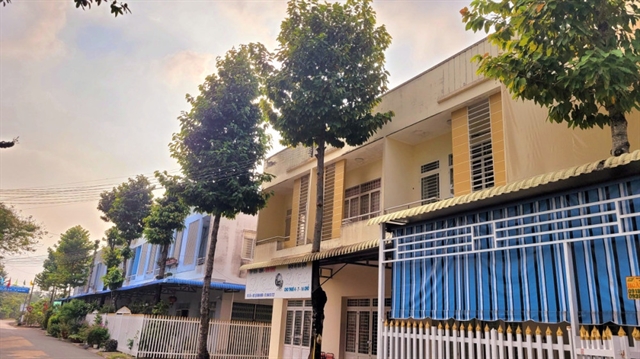 Society
Society

 |
| A social housing project in Long An Province. Due to high demand and delays in many other social housing projects in the province, supply has fallen short of demand. Photo la34.com.vn |
LONG AN — Despite ambitious plans to meet rising demand for social housing, the implementation of such projects in Long An Province remains slow and far from meeting expectations, with most developments progressing well behind schedule.
The demand for social housing in the province is projected to reach approximately 119,000 units by 2030 and around 159,000 units by 2050.
In response, the provincial People's Committee of Long An has issued a Social Housing Development Scheme until 2025, with an orientation towards 2030. Under the plan, the province aims to complete 22,500 units by 2025 and 71,250 units by 2030.
However, as of mid-2025, only modest progress has been made. According to the Long An Department of Construction, seven social housing projects have been completed province-wide, covering a total area of about 5.41 hectares, delivering nearly 2,000 apartments that currently provide accommodation for approximately 8,000 people.
During the 2021–2024 period alone, only one project — with 460 apartments — was completed.
In the first six months of this year, construction began on two more social housing projects with a combined area of over 17 hectares and nearly 1,350 apartment units.
Implementation delays and policy adjustments
Đặng Hoàng Tuấn, director of the Long An Department of Construction, acknowledged that local authorities and departments had made considerable efforts to identify and reserve land for social housing, particularly in industrial zones, residential areas, and urban centres.
However, investment progress remained significantly behind target.
Recognising these nationwide challenges, the Government issued Decision No. 444/QĐ-TTg on February 27, 2025, revising project timelines and reducing Long An’s target to 2,000 completed social housing units this year — substantially lower than the original target set under the provincial plan.
According to Tuấn, the development of social housing projects continues to face numerous obstacles. Chief among them is the delay in land clearance and compensation, which remains a major bottleneck.
“In many cases, investors and local authorities have not shown the necessary urgency, leading to prolonged difficulties and delayed project implementation,” he said.
While administrative procedures for investment and construction have seen some improvement, the preparation phases — including compensation, land allocation, project appraisal, and planning approval — still consume excessive time.
Furthermore, some legal and policy frameworks, including investment incentives, remain underwhelming and fail to offer a compelling advantage over commercial real estate, discouraging investors from committing capital.
Solutions and the road ahead
To address these issues and accelerate progress, the Department of Construction will implement the mechanisms and policies outlined in Resolution No. 201/2025/QH15 passed by the National Assembly. This resolution serves as a vital legal foundation for expediting social housing development.
In addition, the department is urging developers to expedite investment procedures to meet conditions for commencing construction.
In the second half, the Department of Construction plans to coordinate with relevant agencies and local authorities to complete the necessary documentation for five new projects covering 21.5 hectares and is expected to deliver more than 3,500 housing units.
The province will also prioritise the selection of investors for both concentrated and stand-alone social housing projects.
In industrially developed localities such as Đức Hòa, Bến Lức, and Cần Giuộc, special attention will be paid to reviewing urban plans to allocate areas for comprehensive social housing zones — complete with technical and social infrastructure.
 |
| A social housing project for workers in Long Hậu Industrial Park, Long An Province, aims to improve living conditions for industrial labourers. Photo cafef.vn |
Improving procedures, boosting investor confidence
In tandem with these efforts, the Department of Construction, along with other departments and local People’s Committees, will adopt specific solutions to shorten administrative procedures — particularly those involving project appraisal, land allocation, clearance, environmental assessments, and investment licensing.
“Procedures requiring inter-agency collaboration must be resolved proactively and in coordination,” said Tuấn. “For matters beyond local authority, timely reports will be submitted to the provincial People’s Committee for guidance and resolution.”
The overarching goal is to support and encourage businesses to invest in social housing by improving policy implementation, expanding housing supply, and taking full advantage of the Government’s preferential lending packages dedicated to social housing development.
While challenges remain, Long An’s renewed focus on legal reform, administrative efficiency, and investor facilitation offers hope that the province will soon begin to close the gap between rising demand and actual housing supply.— VNS




